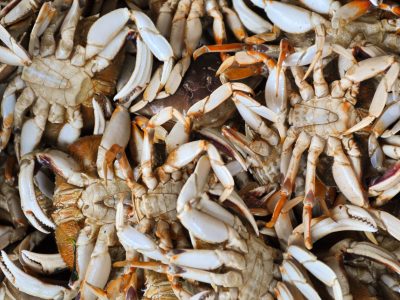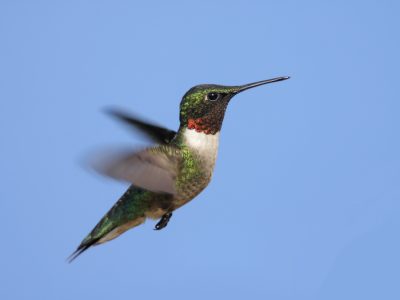King Cobra
Ophiophagus hannah
They are the longest venomous snake in the world.
Advertisement
King Cobra Scientific Classification
- Kingdom
- Animalia
- Phylum
- Chordata
- Class
- Reptilia
- Order
- Squamata
- Family
- Elapidae
- Genus
- Ophiophagus
- Scientific Name
- Ophiophagus hannah
Read our Complete Guide to Classification of Animals.
King Cobra Conservation Status
King Cobra Facts
- Prey
- Lizards, birds, other snakes
- Main Prey
- Other Snakes
- Name Of Young
- Hatchlings
- Group Behavior
- Solitary except during mating season
- Fun Fact
- They are the longest venomous snake in the world.
- Estimated Population Size
- Unknown
- Biggest Threat
- Poaching, habitat loss
- Most Distinctive Feature
- An expanding hood
- Other Name(s)
- hamadryad
- Gestation Period
- 66-105 days
- Litter Size
- 21 to 40 eggs
- Habitat
- Forest, shrublands, wetlands
- Diet
- Carnivore
- Lifestyle
- Diurnal
- Type
- Reptile
- Common Name
- King Cobra
- Location
- South and southeast Asia
- Group
- Solitary
View all of the King Cobra images!
“The king cobra is the longest venomous snake in the world”
King cobras measure an average of 11 to 13 feet long. They live in southern China, India, and southeastern Asia. Their habitat includes streams, forests, bamboo thickets, and swamps. This snake is a carnivore eating other snakes, birds, and lizards. King cobras live about 20 years in the wild.
Incredible King Cobra Facts
- It’s the only snake that builds a nest for its eggs.
- They have enough venom in their bite to kill an elephant.
- This reptile raises the top third of its body and expands its hood when it feels endangered.
- Humans are the only predators of adult King Cobras (mongooses prey on juvenile snakes).
- King cobras are the largest venomous snake. The largest king cobra ever measured nearly 19 feet and lived at the London Zoo during World War 2!
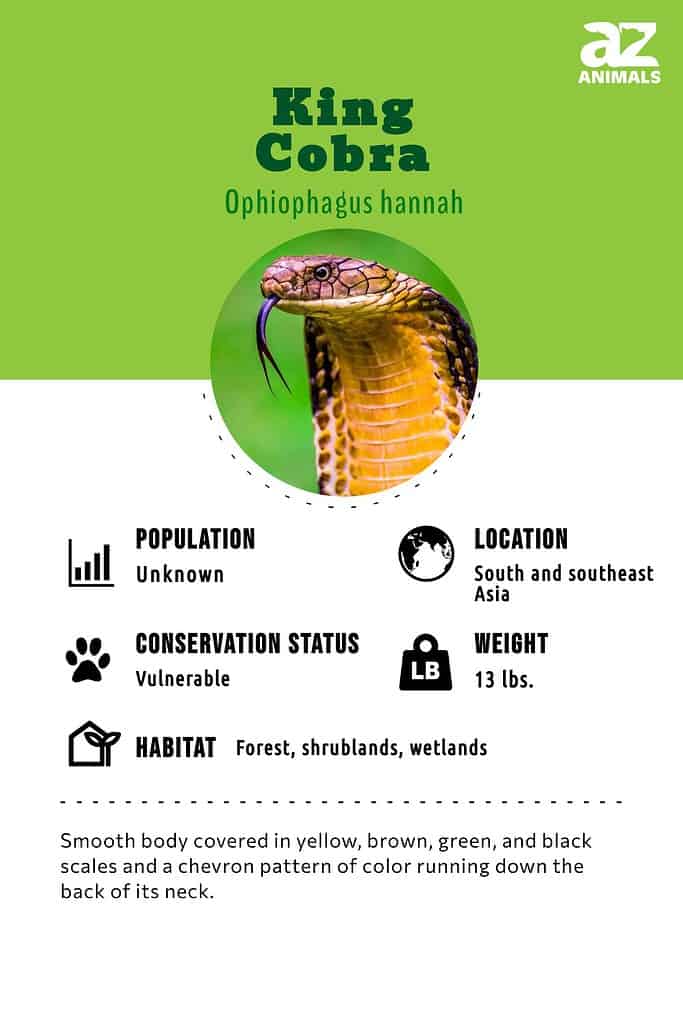
Scientific Name
A king cobra’s scientific name is Ophiophagus hannah. The Greek word Ophiophagus means snake eating and hannah is a reference to a Greek myth about tree-dwelling fairies. The king cobra eats other snakes and lives a lot of its life in trees. It sometimes goes by the name hamadryad. It belongs to the Elapidae family and is in the Reptilia class.
New research shows that the king cobras in Thailand may be an entirely different Ophiophagus species. They appear genetically distinct, but more research is needed to verify this.
There are 20 different related species of cobra including the forest cobra, the Ashe’s spitting cobra, the Mozambique cobra, and the Indian cobra. These are part of the Naja genus, or “true cobras.”

A king cobra’s scientific name is
Ophiophagus hannah
. The Greek word
Ophiophagusmeans snake eating and
hannahis a reference to a Greek myth about tree-dwelling fairies.
©mrjo/Shutterstock.com
History and Evolution
Cobras and the King Cobra evolved to have a hooded neck and head area. This protuberance is an expansion of the snake’s ribcage. These ribs are also able to pull outward the King Cobra’s excess skin in this area. It is believed that these deadly snakes adapted this feature in order to appear larger and more fearsome to any would-be threats in the wild. They couple this tactic with a loud and aggressive hiss that is meant to also scare off predators.
Research from scientists on cobra venom has actually led to the production of medicine, namely Cobroxin, that functions as a painkiller. Particularly, they are being used to stop transmission from nerves and even severe arthritis. Due to successful ventures in this type of research, there is ongoing testing and development of medicine derived from snake toxins.
Appearance
A king cobra is an animal with a smooth body that is covered in yellow, brown, green, and black scales. It has a chevron pattern of color running down the back of its neck. Some king cobras are leucistic. A leucistic king cobra is missing some most of its coloration and looks white. It’s not an albino because it has blue eyes as opposed to pink ones. A leucistic king cobra has all the qualities of a king cobra with the exception of its black, green, brown, and yellow scales.
King cobras are animals that have two dark eyes and fangs that are a half-inch long. A half-inch may sound very short for a snake’s fangs. But, they have to be short, so they won’t press through its lower jaw when it closes its mouth.
This snake can measure 12 to 18 feet long. As an example, an 18-foot-long king cobra is equal in length to 2/3 of a London bus! Compare this to the forest cobra that grows to be just 10 feet long. No wonder the king cobra is known as the longest venomous snake in the world.
The king cobra weighs between 11 and 20 lbs. A 20 lb king cobra is equal in weight to two gallons of paint. The heaviest king cobra lived in the New York Zoological Park and weighed just under 28 lbs. Male king cobras grow to be a little bigger than females. Read here to learn about the largest cobras in the world.
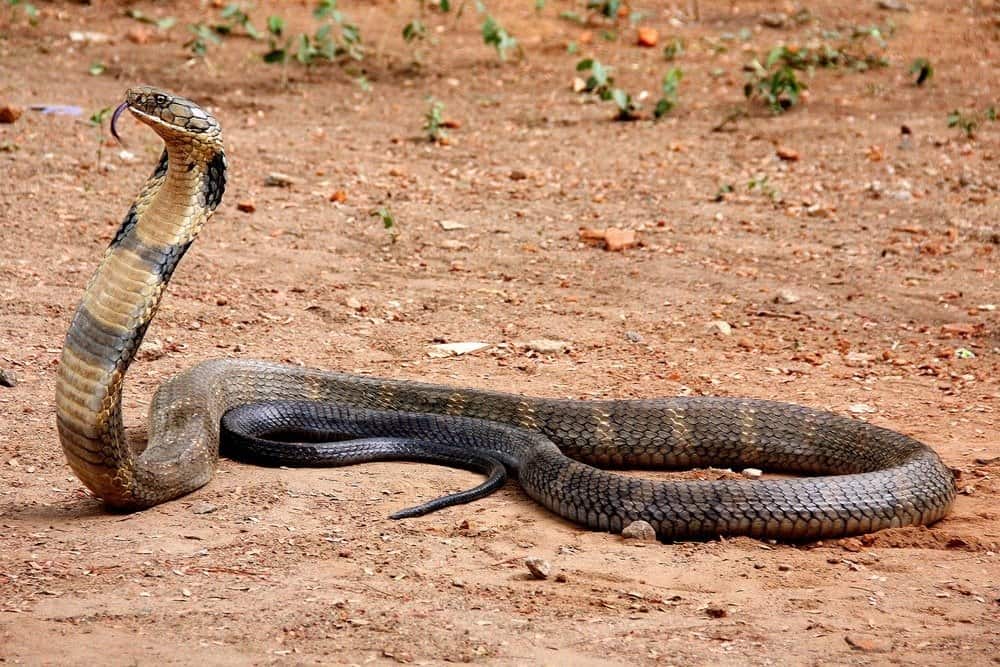
Measuring up to 18 feet long, the king cobra is known as the
longest venomous snake
in the world.
©Jolly Therattil/Shutterstock.com
Behavior
Though this snake is known for being aggressive, it has a shy nature. It would rather steer clear of people and other animals, if possible. It’s considered a solitary reptile. However, the group is called a quiver when they are seen together during the breeding season.
This reptile’s dark brown, green, and black scales allow it to blend in with its environment. However, when it feels threatened by an animal or human, it will expand its hood and raise the top half of its body off the ground. This is so it can move freely and meet the eye of whatever is threatening it. Also, this snake shows its fangs and hisses at the threat. Some people say that a king cobra’s hiss sounds a lot like a dog’s growl.
The defensive stance of a king cobra is a big part of the reason why they are considered to be aggressive reptiles. It’s enough to scare smaller animals away! However, these reptiles are simply defending themselves from threats.
The venom of a king cobra is not the strongest of all snakes, but the amount of venom it can inject in a person or animal in one bite is enough to kill an elephant or 20 people. The venom causes respiratory distress and cardiac failure. This would definitely qualify as a defensive feature of this snake!

Though this snake has a reputation for being aggressive, it actually has a shy nature.
©CappaPhoto/Shutterstock.com
Habitat
King cobras live in parts of southeast Asia, southern China, and India. Their habitat includes forests, bamboo thickets, streams, and swamps. These snakes live in a warm, humid climate.
They spend most of their time in trees blending into the dense, leaf-filled branches. They sometimes hang down from a tree branch to capture another snake. Other times king cobras come down from the trees to hunt for prey on the forest floor. They may travel to nearby streams to look for food. These reptiles can swim fairly well and have been seen moving along through the water.
When the weather cools off in late fall and winter, king cobras migrate to dens to stay warm. They come back out in the springtime.
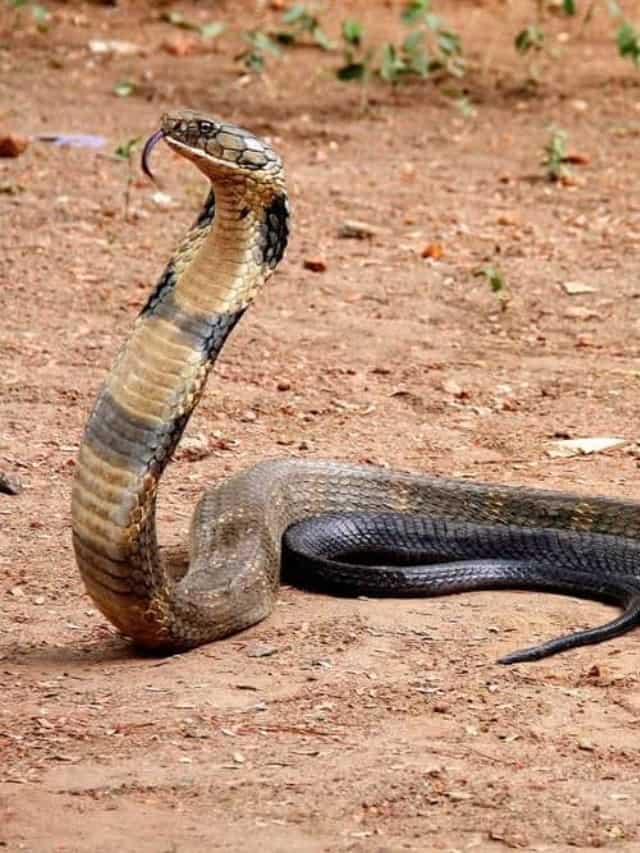
The king cobra’s habitat includes forests, bamboo thickets, streams, and swamps.
©Jolly Therattil/Shutterstock.com
Diet
What do king cobras eat? King cobras are carnivores eating birds, lizards, and other snakes. When those are scarce, these snakes will eat small rodents. If a king cobra eats a large amount of prey at one time, it may not eat again for a few months.
This snake has excellent eyesight. It can sometimes spot prey while resting on a high branch in a tree. Like other snakes, it also has an impressive sense of smell.
King cobras are fast and move quickly to strike their prey without having to hold it in place like other cobras.
To discover our complete guide on the diet of king cobras, make sure to check out ‘What Do King Cobras Eat: 11+ Foods in their Diet.’
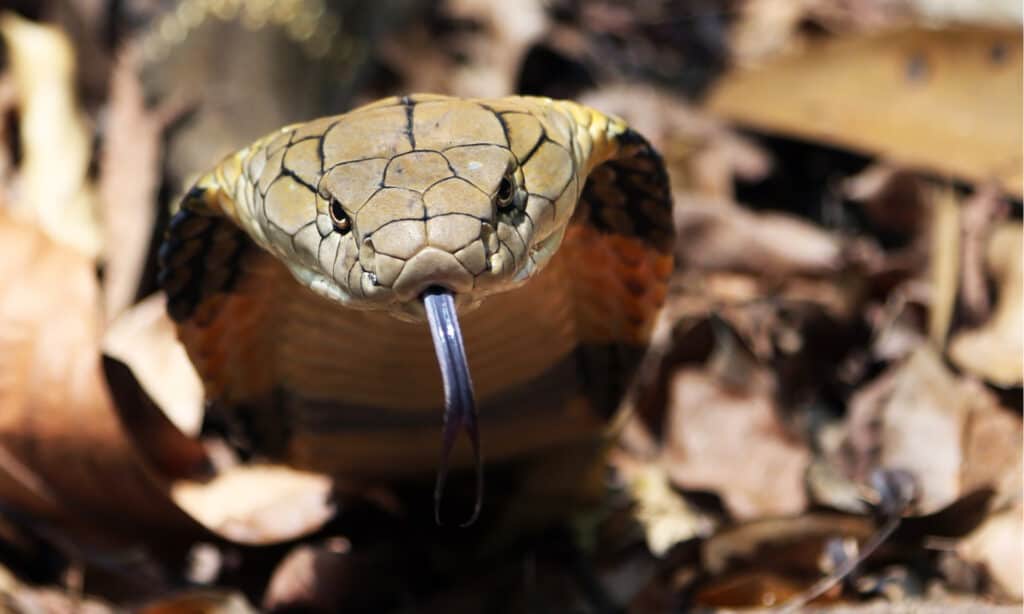
King cobras have an impressive sense of smell.
©Suresh Suryasree/Shutterstock.com
Predators and Threats
Poachers sometimes set traps for these snakes and kill them for their skin, to make medicine or even to eat. Some of these reptiles are sold illegally as exotic pets.
However, humans are not the only predators of the king cobra. Mongooses, honey badgers, and secretary birds also prey on them. The mongoose is immune to small amounts of their venom, but they really win the fight using their speed and agility.
Since these reptiles need a certain type of environment to thrive and they have a venom that is capable of killing a human, it’s definitely not a good idea for anyone to keep one as a pet.
In southeast Asia, snake charmers sometimes use king cobras in their street performances. They pretend like the king cobra is charmed by the music they’re playing on the flute. These snakes have been known to bite snake charmers as well as escape into an environment where they can’t survive.
Habitat loss due to deforestation and land clearing is another threat to king cobras.
The official conservation status of king cobras is Vulnerable with a decreasing population. Though they are on the endangered list of species in India, this country is taking steps to protect them. They are focusing on properly educating the public about these reptiles. Plus, they are also microchipping king cobras so they can track them if they are captured by exotic pet dealers. Vietnam has given these snakes a protected species status.
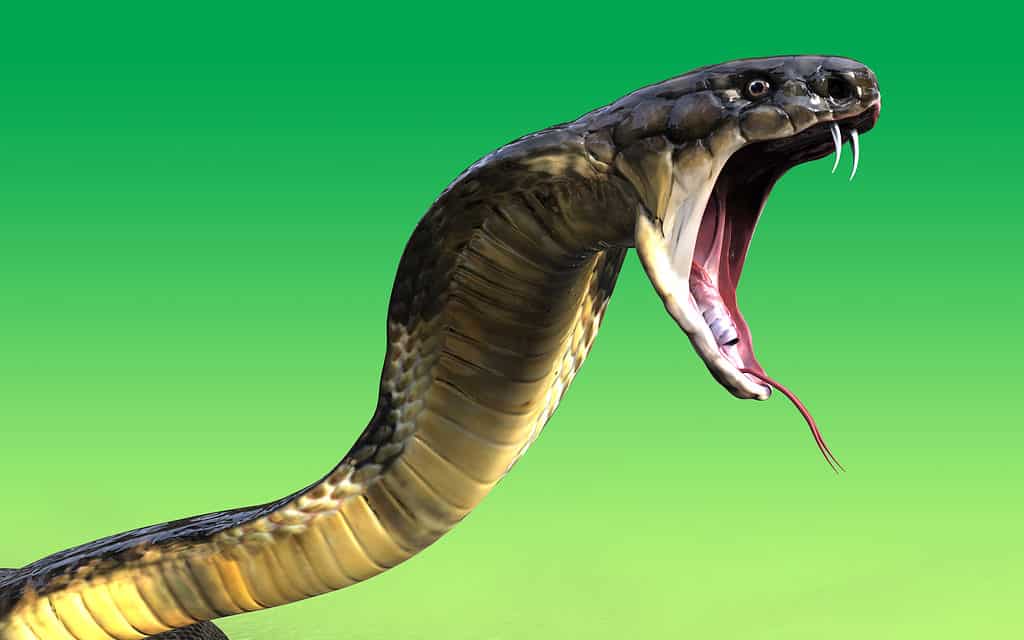
King cobras have been known to bite snake charmers as well as escape into an environment where they can’t survive.
©mrjo/Shutterstock.com
Reproduction and Life Cycle
The breeding season of a king cobra goes from January to April. When a male king cobra is interested in a female, it pushes her body with its head. If other male king cobras are in the area, the males wrestle and the strongest one mates with the female. King cobras are monogamous (stay with the same mate each breeding season).
The female creates a nest by pushing twigs, grass, and other vegetation into a pile. The temperature within the pile/nest is around 80 degrees Fahrenheit. Shortly after, she lays 21 to 40 (sometimes more) eggs in the nest. The eggs hatch between 51 and 79 days later. As a note, the king cobra is the only snake that builds a nest for its eggs. The female stays with the nest and fiercely guards her eggs from predators until they hatch. Consequently, most of the king cobra eggs will hatch and the babies will survive.
Baby king cobras are called hatchlings. Each hatchling can weigh from less than an ounce to one and a half ounces. The hatchlings usually measure from 12 to 29 inches long. A 12-inch-long hatchling is equal to the size of a small wooden ruler.
The hatchlings are brightly colored. This helps to scare off predators. As they grow, their scales turn dark brown, black, and green. They leave the nest to hunt prey and live independently right after hatching. The venom of a hatchling is every bit as powerful as an adult king cobra. Keep that in mind in case you ever see one!
These reptiles are vulnerable to various types of skin fungi. The lifespan of a king cobra in the wild is around 20 years. But the oldest king cobra record is held by a snake that reached 22 years of age!
Population
The exact population of king cobras is unknown. However, the conservation status of the king cobra is Vulnerable. Its population is decreasing. Loss of habitat and poaching activity are two major threats to the population of this snake. It’s on the endangered species list in India.
Similar Animals
- A Mozambique spitting cobra can spit venom almost 10 feet.
- Indian cobras are also known as spectacled cobras.
- The Forest cobra is one of the longest true cobras.
King Cobra FAQs (Frequently Asked Questions)
Are king cobras considered intelligent?
Yes, king cobras are generally considered to be the most intelligent species of snakes. Among factors that lead to this perception of intelligence is that appear to recognize their handlers, approach hunting of different prey with new strategies, and they build large nests that no other snake species builds.
What snakes other than king cobras eat other snakes?
Other than king cobras, a number of snakes will eat other snakes. Some examples include kingsnakes, king brown snakes, banded kraits, and eastern indigo snakes.
How long is a king cobra?
King cobras can be 12 to 18 feet long. Males are usually a little bit bigger than females.
What are the differences between an Indian and king cobra?
When comparing king cobra vs Indian cobra, the main differences are size and venom potency. King cobras are generally twice the length of Indian cobras, but Indian cobras kill substantially more people every year.
How does a king cobra compare to a black mamba?
When comparing a king cobra vs a black mamba, the two snakes live on different continents with black mambas in Africa while king cobras live in Asia. King cobras are also larger and have a more prominent hood.
King Cobra vs Cobra: Who wins the fight?
King cobras eat other snakes including cobras, so the king cobra would win in a struggle with practically any other type of cobra.
How deadly is a king cobra?
The venom of a king cobra is not particularly strong, but this snake releases a large amount of it. A venomous bite (as opposed to a dry bite with no venom) can kill an elephant or 20 humans. As a note, a dry bite is also dangerous because this snake’s fangs are so sharp they could cause serious injury.
Can you survive a king cobra bite?
Yes. There’s an antivenin that can counteract the venom of a king cobra. The venom of this snake can kill in 30 to 45 minutes from the time of the bite. So, it’s important to get the person to a medical professional as soon as possible.
What is the difference between a cobra and a king cobra?
It may seem like the king cobra and other cobras should be lumped into the same group. But there are some differences. For one, the king cobra belongs to its own genus. A king cobra’s genus is known as Ophiophagus while the Chinese cobra, forest cobra, and many others are categorized under the genus Naja.
Another difference is the king cobra’s head is larger than that of other cobras and its hood is more narrow. They also have two especially large scales on the back of their head that other cobras don’t have. These special scales are called occipitals.
Many cobras are venomous. The spitting cobra lives up to its name by spitting venom at anything threatening it. Egyptian cobras are venomous as well releasing a poison that targets a predator’s nervous system. However, the king cobra claims the title as the longest venomous snake in the group.
Are King Cobras herbivores, carnivores, or omnivores?
King Cobras are Carnivores, meaning they eat other animals.
What Kingdom do King Cobras belong to?
King Cobras belong to the Kingdom Animalia.
How do King Cobras have babies?
King Cobras lay eggs.
What's the difference between a king cobra and a rattlesnake?
There are many differences between a king cobra and a rattlesnake, including their habitats. King cobras have a distinct hood that they use to ward off predators, while rattlesnakes use a rattle.
What's the difference between a king cobra and a gaboon viper?
One difference between gaboon vipers and king cobras is that gaboon vipers are much shorter and heavier bodied than king cobras. Further, gaboon vipers live in select parts of Africa, whereas king cobras are native to India and Southeast Asia. One more key difference is their coloring – king cobras are solid colored, while gaboon vipers have complex patterns to help them blend in with their surroundings.
What are the differences between a cobra and a viper?
The differences between a cobra and a viper are size, location, habitat, appearance, behavior, and lifespan.
Why is the King Cobra's bite so dangerous?
The king cobra bite is so dangerous because of the large amount of venom contained in a single bite. Read all about king cobra bites here!
What's the difference between king cobras and pythons?
King cobras and pythons both live in Asia, but pythons kill with constriction while king cobras kill with venom. The average python also outgrows the average king cobra, but typically in weight rather than length.
What's the difference between king cobras and cobras?
King cobras belong to a different genus compared to cobras, and most cobras don’t grow as large as the king cobra. Plus, king cobras eat other snakes, while many other cobra species don’t do this.
Who would win a fight between a king cobra and a lion?
A lion would win a fight against a king cobra. The lion has many advantages that would help it in this endeavor. For one thing, the lion only needs one bite to completely kill the king cobra. With a running start, it could easily snatch up the snake in its paws and bite its head off before the snake could react.
Who would win a fight between a king cobra and mongoose?
A mongoose would kill a king cobra in a fight. The mongoose specifically hunts venomous snakes throughout its range for food. These animals have some resistance to venomous snake bites, which means they come into this battle with an advantage.
The king cobra needs to bite the mongoose probably more than once to put it down. Meanwhile, the mammal has far more speed and agility, and it can crack a snake’s skull with just a single bite.
Who would win a fight between a king cobra and a crocodile?
A crocodile would win a fight against a king cobra. If the king cobra bites the alligator first, it may not have an impact.
The crocodile’s skin is very thick. While the king cobra has fangs that measure 0.5″ inches, that might not be enough to deliver the venom into the crocodiles’ system. Even then, the crocodile can catch the fleeing snake and kill it.
Who would win a fight between a king cobra and a grizzly bear?
A grizzly bear would win in a fight against a king cobra.
To be clear, a king cobra will certainly kill a grizzly bear, but the chances are good that the grizzly bear will kill the snake before expiring. If the two animals met on a neutral ground that disallowed any ambush, the grizzly bear could kill the snake outright.
Who would win a fight between a king cobra and an alligator?
An alligator would win a fight against a king cobra.
Both animals are ambush predators, so the alligator could wait for the king cobra to come to get a drink of water before attacking and killing it. Likewise, the king cobra could wait in tall grass and bite the alligator, but it’s not fast enough to escape the fight and let the gator die off. The gator would turn on its afterburners and bite the snake.
What's the difference between king cobras and kingsnakes?
King cobras are much larger than kingsnakes, as well as far more venomous. Kingsnakes are also more colorful than king cobras.
What are the key differences between a golden lancehead and a king cobra?
The key differences between a golden lancehead and a king cobra are their size, location, and colors.
What is the difference between a green mamba and a king cobra?
The key differences between Green Mambas and King Cobras are their size, weight, morphology, distribution, diet, and venom. Typically, a Green Mamba is smaller and less heavy than a King Cobra. Besides, while King Cobras have hoods on their heads, Green Mambas, apart from the eastern Green Mamba, don’t have hoods when their heads are raised.
What is the difference between a king cobra and a boomslang?
Size, phylogenic families, distribution, morphology, reproduction, life cycle, and conservation status are the key differences between a boomslang and a king cobra. First, the average king cobra can grow thrice as long as the average boomslang. Furthermore, boomslangs are found in Africa, while king cobras are well distributed in Southeast Asia.
Which is more venomous between a king cobra and a rattlesnake?
King cobras are more venomous than rattlesnakes. Their venom is both potent and comes in higher quantities. However, king cobra bites are rare, much rare than rattlesnake bites. So, pound for pound, the king cobra is more venomous than the rattlesnake, but the rattlesnake presents more of a threat to humans.
Who would win in a fight between a honey badger and a king cobra?
The honey badger would kill the king cobra in a fight.
What are the key differences between mulga snakes and king cobras?
The key differences between mulga snakes and king cobras are size, distribution, lifespan, venom resistance, threat display, and method of attack.
Which is more lethal between a king cobra and a brown recluse spider?
The king cobra is a more lethal hunter than the brown recluse not only because of its more massive size but also because of the potency of its venom relative to its size.
Who would win a fight between a king cobra and a monitor lizard?
A king cobra would win a fight against a monitor lizard.
In the majority of cases, the average monitor lizard is going to be too small or too slow to react to defeat the king cobra. Once the cobra bites the monitor lizard, a timer until its death begins. Sure, a big monitor lizard could potentially fight back. It may even grab the king cobra by the head and bite down, but the chances that it lands the first and only killing blow in this fight are small.
Thank you for reading! Have some feedback for us? Contact the AZ Animals editorial team.
Sources
- Smithsonian National Zoo & Conservation Biology Institute, Available here: https://nationalzoo.si.edu/animals/king-cobra
- National Geographic, Available here: https://www.nationalgeographic.com/animals/reptiles/k/king-cobra/
- Animalia, Available here: http://animalia.bio/king-cobra








